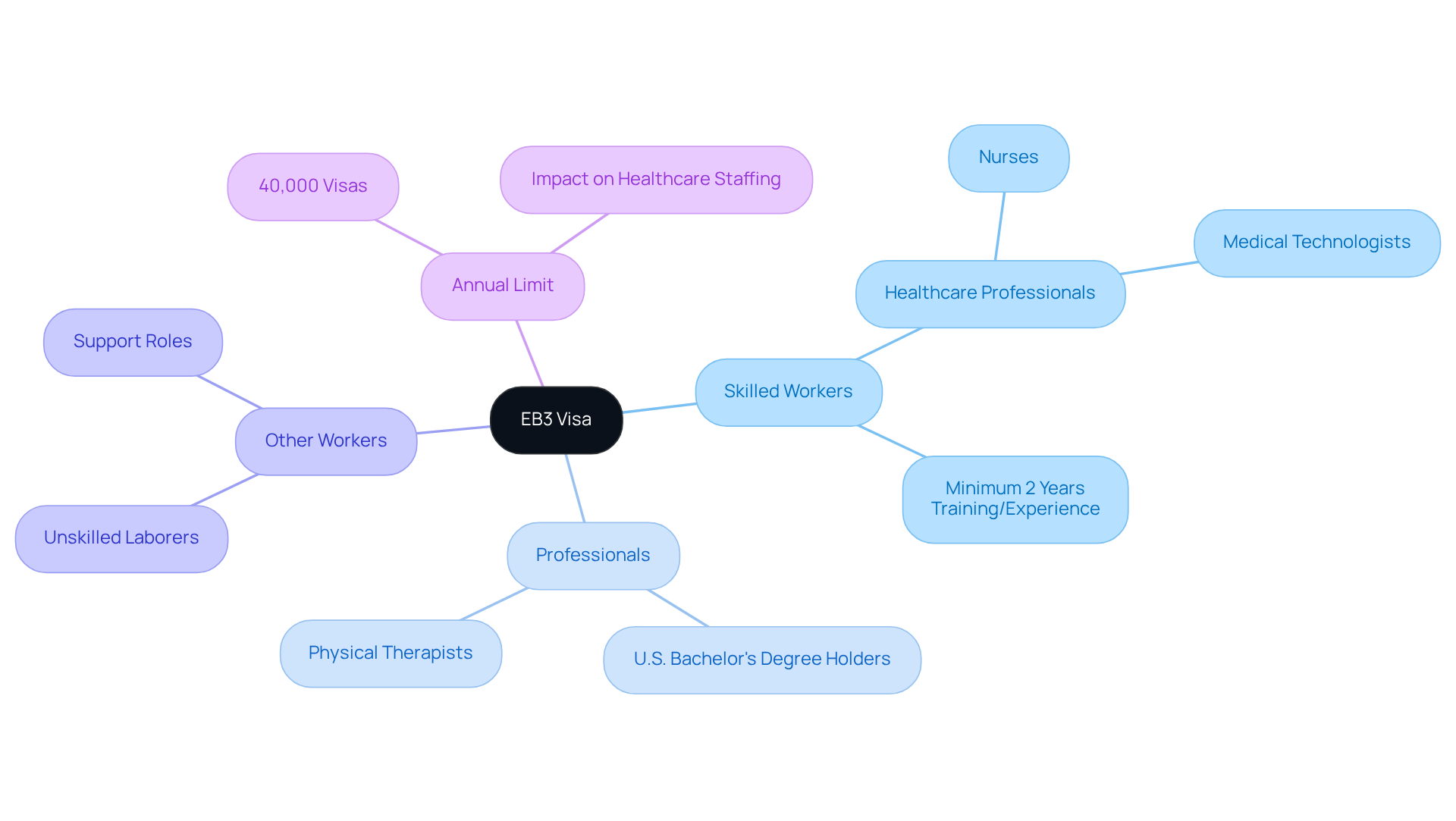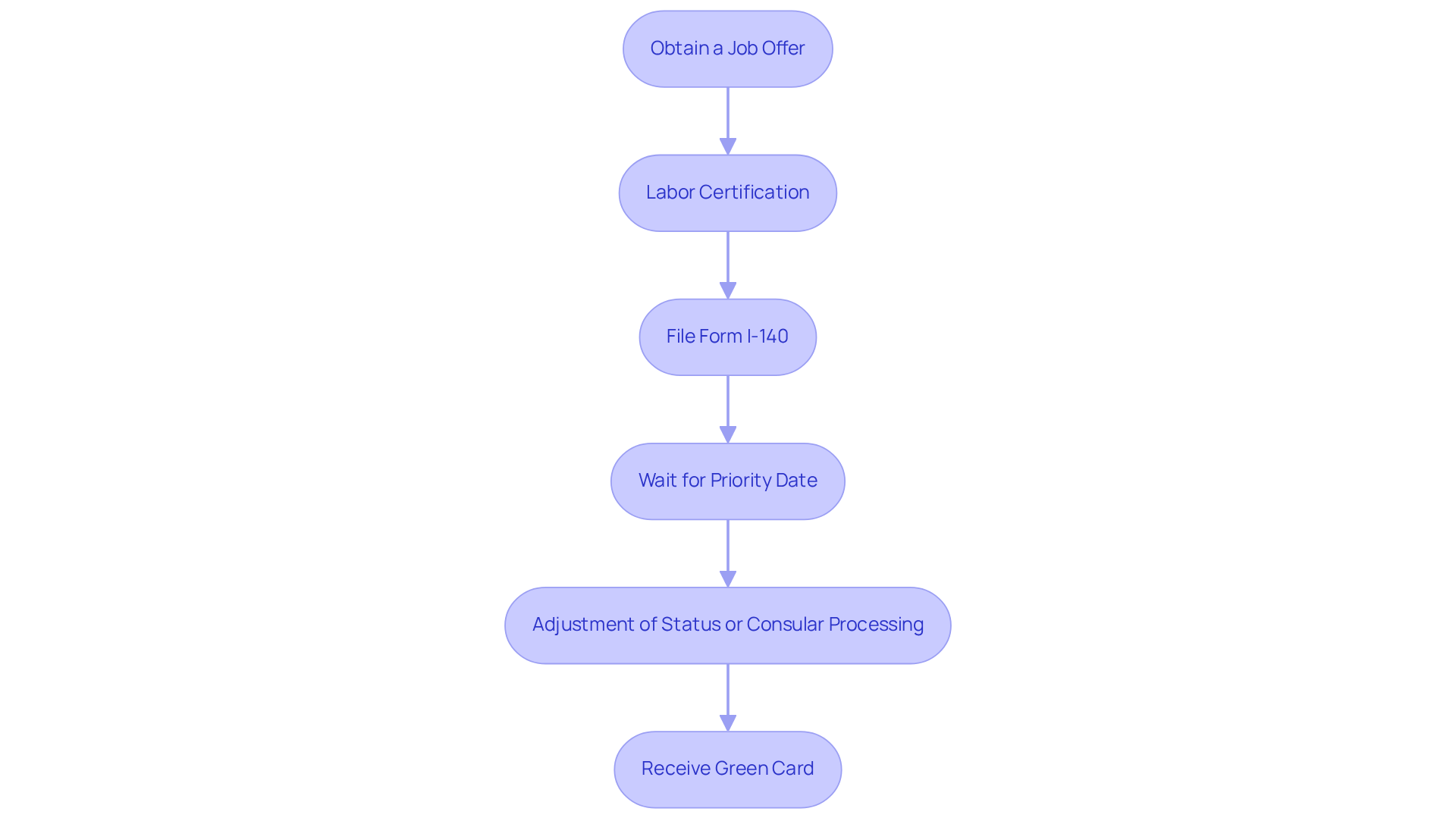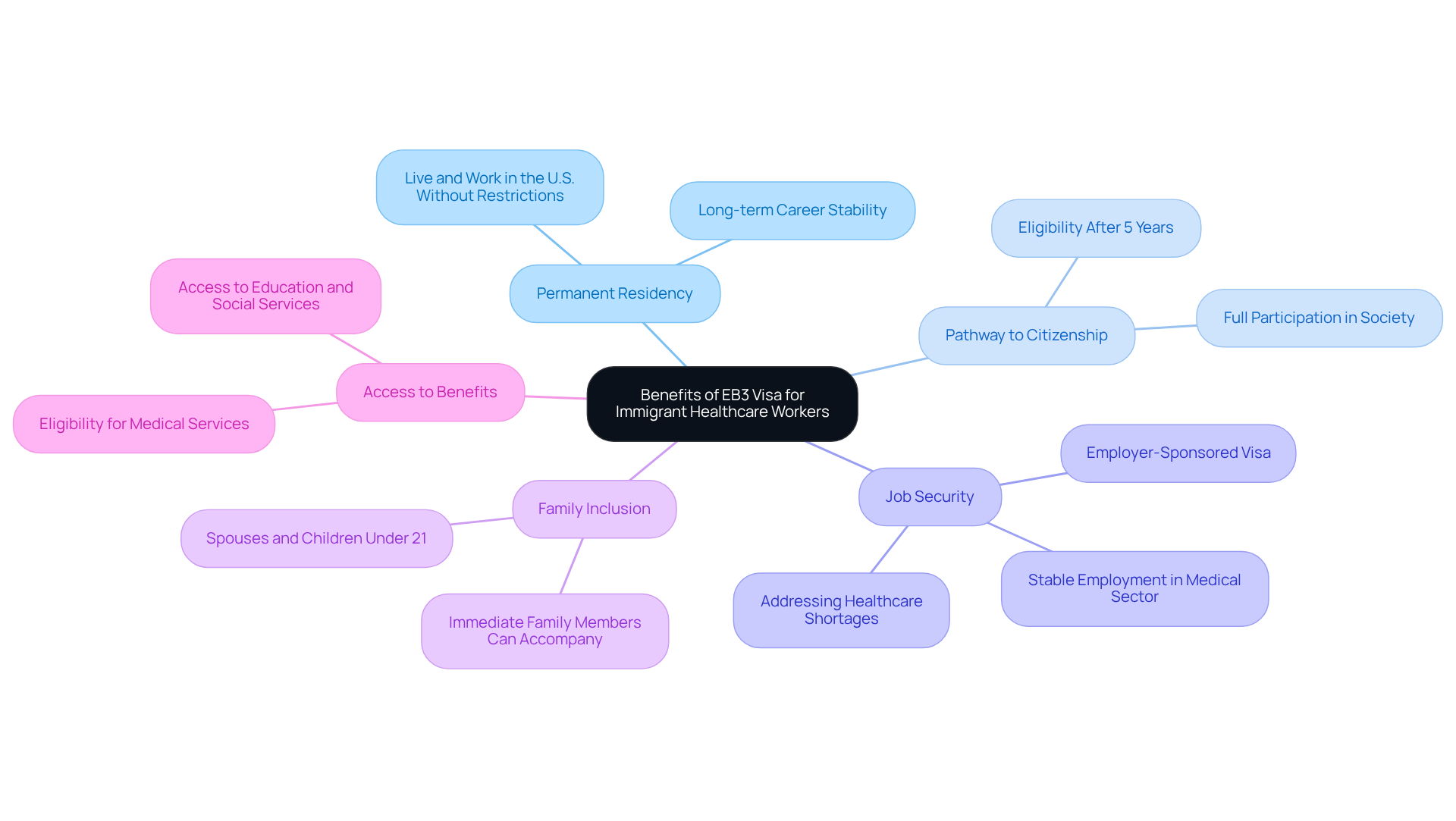Overview
The EB3 visa serves as a vital pathway for immigrant healthcare workers seeking permanent residency in the United States. It is categorized into skilled workers, professionals, and other workers based on qualifications, addressing the real struggles clients face in navigating complex immigration processes. This article outlines essential application steps, eligibility criteria, and the benefits of the EB3 visa. Amidst the U.S. healthcare workforce shortage, it emphasizes the advantages this visa offers, such as job security and the inclusion of family.
Have you ever felt overwhelmed by the immigration system? You’re not alone. The EB3 visa not only opens doors for you but also offers stability and support for your loved ones. It’s crucial to understand that you have options available, and we’re here to help you through every step of this journey.
Your future matters to us. The EB3 visa is more than just a document; it’s a chance for a better life and a way to contribute to the healthcare system that needs you. Together, we will navigate this process, ensuring you feel empowered and informed.
Remember, we’re in this fight with you. Yo Peleo — We Fight.
Introduction
Navigating the complexities of immigration to the United States can feel overwhelming, especially for healthcare professionals eager to make a difference in a system grappling with significant workforce shortages. The EB3 visa emerges as a vital pathway, offering skilled workers, professionals, and other workers a way to secure permanent residency in the U.S. Yet, with an annual cap of 40,000 visas and stringent eligibility criteria, many aspiring applicants find themselves asking:
- What are the essential steps to successfully navigate this process and ensure their future in American healthcare?
This article dives into the intricacies of the EB3 visa, providing a comprehensive guide for immigrant healthcare workers to understand their options, meet the requirements, and ultimately achieve their career aspirations in the United States.
Define the EB3 Visa: Purpose and Categories
The visa EB3 serves as a vital pathway for to secure in the United States. This employment-based immigrant visa is divided into three key categories:
- Skilled Workers: This group includes individuals who have at least two years of training or experience in a specific occupation. Many , such as nurses and medical technologists, often qualify under this classification.
- Professionals: Designed for those holding a U.S. bachelor's degree or its foreign equivalent, this category encompasses various medical roles, including physical therapists.
- Other Workers: This category consists of unskilled laborers who can perform jobs requiring less than two years of training. Although less common in the medical field, some support roles may be eligible.
It's important to note that the remains around 40,000, unchanged since 1990. This limit can significantly impact the availability of permits for healthcare professionals, especially as the U.S. faces a of nearly 200,000 registered nurses each year. is crucial for applicants to and the specific criteria needed for . Remember, you’re not alone in this process; we’re here to .

Outline EB3 Visa Requirements: Eligibility Criteria
To qualify for the , applicants must meet several key requirements:
- Job Offer: A from an American employer willing to sponsor the applicant is essential.
- : The employer must obtain a labor certification from the Department of Labor, confirming that no qualified American workers are available for the position. This step is crucial, as it demonstrates the employer's genuine effort to recruit domestically.
- Qualifications: Depending on the category:
- Skilled Workers: Applicants must have at least two years of training or experience in their field.
- Professionals: A U.S. bachelor's degree or its foreign equivalent is required.
- Other Workers: Applicants must be capable of performing unskilled labor that requires less than two years of training.
- Background Check: A is mandatory, and applicants must not have any disqualifying factors, such as a criminal history or immigration violations.
- : in English during the USCIS application process.
These criteria ensure that only qualified individuals can apply for the visa EB3. Recent statistics indicate that approximately 70% of applicants successfully meet these requirements, underscoring the importance of thorough preparation. For instance, healthcare professionals often benefit from , which includes roles such as registered nurses and physical therapists, allowing them to bypass the labor certification requirement due to recognized shortages in the U.S. workforce. Real-world examples, such as Maria, a registered nurse from the Philippines, who successfully navigated the visa EB3 application process with the help of legal guidance, highlight the effectiveness of meeting these criteria and securing the necessary documentation. Furthermore, spouses and unmarried children under 21 years old of EB-3 holders can apply for derivative permits, allowing families to remain united during the immigration process. Therefore, it is essential for to enhance their chances of approval.
 requirements. Each branch shows a key requirement, with further details in sub-branches. This layout helps you see what is needed to qualify for the visa and how each requirement is connected.](https://images.tely.ai/telyai/dcwxrejw-the-center-represents-the-eb-3-visa-requirements-each-branch-shows-a-key-requirement-with-further-details-in-sub-branches-this-layout-helps-you-see-what-is-needed-to-qualify-for-the-visa-and-how-each-requirement-is-connected.webp)
Explain the EB3 Visa Application Process: Step-by-Step Guide
Navigating the application process for the can feel overwhelming, but you don’t have to tackle it alone. Here are the key steps to guide you through:
- Obtain a Job Offer: Start by securing a full-time job offer from a U.S. employer willing to sponsor your work authorization application. This is your first step toward a brighter future.
- : Your employer will need to submit a labor certification application to the Department of Labor. This step proves that there are no qualified American workers available for the position, ensuring your opportunity.
- : Once the labor certification is approved, your employer must file Form I-140, Immigrant Petition for Alien Worker, with USCIS. This form is crucial in moving your application forward.
- : After submission, patience is key. You’ll need to wait for your priority date to become current, as there are annual limits on EB3 permits. We understand how challenging this can be.
- or Consular Processing: Depending on your location, you will either file for Adjustment of Status (Form I-485) if you’re in the U.S., or go through consular processing at a U.S. embassy or consulate if you’re abroad. Knowing your options is empowering.
- : Finally, upon approval, you will receive your Green Card, granting you in the U.S. This is a significant milestone in your journey.
Following these steps carefully is crucial for a successful visa EB3 application. Remember, we’re here to fight for your family and support you every step of the way.

Highlight Benefits of the EB3 Visa for Immigrant Healthcare Workers
The offers significant advantages for , making it a strong choice for those seeking to build their careers in the United States.
- : Successful applicants gain permanent residency, enabling them to live and work in the U.S. without restrictions. This is crucial for long-term career stability.
- : After holding a for five years, individuals can apply for U.S. citizenship, allowing full participation in American society and its opportunities.
- : The visa EB3, as an employer-sponsored permit, often leads to stable employment in the medical sector, addressing the urgent demand for healthcare professionals in the U.S. This is especially relevant given the ongoing shortages in various healthcare roles. The annual limit for the visa EB3 is established at 28.6 percent of the worldwide employment limit, emphasizing the competitive nature of this visa category.
- Family Inclusion: Visa holders can bring their immediate , including spouses and children, to the United States. This ensures families can stay united during their transition.
- : Permanent residents become eligible for a variety of benefits, including medical services, education, and social services, which are vital for successful integration into American life.
Real-world examples illustrate the impact of the visa EB3 program: many immigrant medical workers have successfully navigated the visa EB3 process, securing their permanent residency and significantly contributing to the U.S. medical system. These advantages highlight why in the United States find the visa EB3 to be an appealing option.

Conclusion
The EB3 visa represents a vital opportunity for immigrant healthcare workers striving to build their lives and careers in the United States. By offering a pathway to permanent residency, this employment-based visa directly addresses the urgent need for skilled professionals in the healthcare sector, especially in light of ongoing shortages. Grasping the complexities of the EB3 visa—its categories, eligibility requirements, and application process—empowers applicants to navigate this intricate journey with confidence.
Throughout this article, we’ve shared key insights regarding the various categories of the EB3 visa, the specific requirements for each classification, and a detailed step-by-step guide for the application process. The benefits of securing an EB3 visa, including permanent residency, family inclusion, and access to essential services, highlight its significance for healthcare workers seeking stability and growth in their professional lives.
As the demand for healthcare professionals in the U.S. continues to surge, the EB3 visa stands as an essential tool for immigrant workers. It not only facilitates their entry into a critical sector but also enriches the healthcare landscape by attracting diverse talent. For those contemplating this path, thorough preparation and a solid understanding of the process can lead to successful outcomes, ultimately enhancing both individual careers and the broader healthcare workforce in the United States. Remember, you’re not alone in this fight—we’re here to support you every step of the way.
Frequently Asked Questions
What is the purpose of the EB3 visa?
The EB3 visa serves as a pathway for foreign nationals seeking to secure permanent residency in the United States through employment.
What are the three key categories of the EB3 visa?
The three key categories of the EB3 visa are Skilled Workers, Professionals, and Other Workers.
Who qualifies as a Skilled Worker under the EB3 visa?
Skilled Workers are individuals who have at least two years of training or experience in a specific occupation, such as healthcare professionals like nurses and medical technologists.
What qualifications are required for the Professionals category of the EB3 visa?
The Professionals category is designed for individuals holding a U.S. bachelor's degree or its foreign equivalent, which includes various medical roles like physical therapists.
What does the Other Workers category include?
The Other Workers category consists of unskilled laborers who can perform jobs requiring less than two years of training, including some support roles in the medical field.
Is there an annual limit for the EB3 visa, and what is its significance?
Yes, the annual limit for the EB3 visa is around 40,000, unchanged since 1990. This limit can significantly impact the availability of permits for healthcare professionals, especially amid a nursing shortage in the U.S.
Why is it important for applicants to understand the EB3 visa categories?
Understanding the EB3 visa categories is crucial for applicants to assess their eligibility and the specific criteria needed for visa applications.




